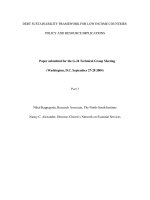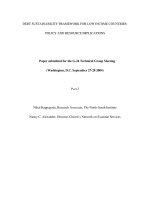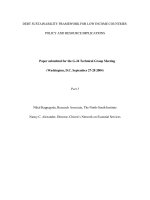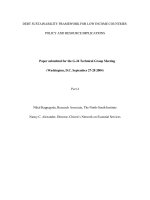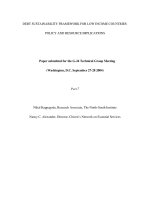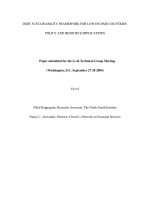Tài liệu DEBT SUSTAINABILITY FRAMEWORK FOR LOW INCOME COUNTRIES : POLICY AND RESOURCE IMPLICATIONS - Part 9 pptx
Bạn đang xem bản rút gọn của tài liệu. Xem và tải ngay bản đầy đủ của tài liệu tại đây (19.25 KB, 6 trang )
DEBT SUSTAINABILITY FRAMEWORK FOR LOW INCOME COUNTRIES:
POLICY AND RESOURCE IMPLICATIONS
Paper submitted for the G-24 Technical Group Meeting
(Washington, D.C. September 27-28 2004)
Part 9
Nihal Kappagoda, Research Associate, The North-South Institute
Nancy C. Alexander, Director, Citizen’s Network on Essential Services
1
Annex 1
Debt Indicators
Liquidity Monitoring Ratios
a) The Debt Service Ratio is the proportion of exports of goods and non
factor services that is absorbed for debt service payments, i.e., interest,
principal and other payments. The basic ratio refers only to long and
medium-term debt which covers all loans with an original maturity of
one year and above.
b) The Interest Service Ratio is the ratio of interest payments to exports
of goods and non-factor services.
c) The Short-Term Debt ratio measures the proportion of exports of
goods and non factor services that will be absorbed if all debt
outstanding with an original maturity of one year at the end of the
preceding year is paid without roll over.
2
d) Total Debt Service Ratio is the proportion of exports of goods and
non- factor services that are absorbed for debt service payments on both
long and short-term debt.
Debt Burden Ratios
a) The total debt outstanding to GDP or GNI ratio compares the amount
of disbursed debt outstanding to the size of the economy.
b) The total debt outstanding to exports of goods and non-factor services
ratio measures the ability of the country to repay its debt in a single year
from its earnings from goods and non-factor services.
c) Public debt outstanding to GDP or GNI ratio compares the total of
domestic and external outstanding to the size of the economy.
Present Value Indicators
a) The Present Value of Debt Service to GDP or GNI ratio compares the
current cost of future debt service obligations to the overall level of
economic activity in the country. Only the current year’s PV is
3
compared to the average GDP/GNI of the current and two preceding
years.
b) The Present Value of Debt Service to exports of goods and services
compares the current cost of future debt service obligations to the
capacity of the country to generate foreign exchange receipts. Only the
current year’s PV is compared to the average exports of goods and
services of the current and two preceding years. Only the current year’s
PV is used in both present value indicators to take account of the latest
debt situation in the country.
Debt Structure Indicators
a) The Roll Over Ratio compares principal repayments to
disbursements. It could be estimated separately for short-term and long-
term debt.
b) The ratio of short-term debt to total debt outstanding measures the
vulnerability of a country’s debt situation brought about by its debt
structure.
Dynamic Indicators
4
a) The ratio of the average rate of interest of the loan portfolio to the
growth rate of exports determines whether debt service is growing faster
than exports.
b) The ratio of the average rate of interest of the loan portfolio to the
growth rate of GDP determines whether debt service is growing faster
than the economy.
Fiscal Indicators
a) The ratio of government debt (domestic and foreign) service
payments to government revenue.
b) The ratio of government debt (domestic and foreign) outstanding to
government revenue.
c) The ratio of the present value of government debt service to
government revenue.
5
